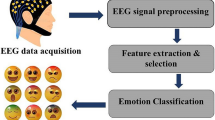Abstract
Developed countries are experiencing a dramatic increase in population ageing. Moreover, it is well known that elderly prefer stay at their homes over other options, increasing this way the medical expenditures. This also involves a major impact on the social and economic balance of the countries. Consequently, an important number of works have been carried out to improve the elderly quality of life and reduce the healthcare costs. However, few efforts have been made in monitoring the mental and emotional states of the ageing adults. This paper introduces a new approach based on the dynamic quadratic entropy for distinguishing different arousal levels. 278 one-minute-length EEG recordings from Dataset for Emotion Analysis using Physiological Signals are used in this study. The results show a decreasing brain complexity under excitement stimuli in central and parietal areas. These findings could be useful to train an emotional system for recognizing some basics emotions.
Access this chapter
Tax calculation will be finalised at checkout
Purchases are for personal use only
Preview
Unable to display preview. Download preview PDF.
Similar content being viewed by others
References
Trustees, M.: Technical review panel on the medicare trustees report, Review of the Assumptions and Methods of the Medicare Trustees
Fernández-Caballero, A., Latorre, J.M., Pastor, J.M., Fernández-Sotos, A.: Improvement of the elderly quality of life and care through smart emotion regulation. In: Ambient Assisted Living and Daily Activities, pp. 348–355. Springer (2014)
United Nations Department of Economic, World population ageing 2009, vol. 295. United Nations Publications (2010)
World Health Organization, et al.: Global health and ageing
Pantelopoulos, A., Bourbakis, N.: A survey on wearable systems for monitoring and early diagnosis for the elderly. IEEE Transactions on Systems, Man and Cybernetics, Part C: Applications and Reviews 1, 1–12 (2010)
Kario, K., Yasui, N., Yokoi, H.: Ambulatory blood pressure monitoring for cardiovascular medicine. IEEE Engineering in Medicine and Biology Magazine 22(3), 81–88 (2003)
Jovanov, E., Milenkovic, A., Otto, C., De Groen, P.C.: A wireless body area network of intelligent motion sensors for computer assisted physical rehabilitation. Journal of NeuroEngineering and Rehabilitation 2(1), 6 (2005)
Garth, C., Tirthankar, G., Renita, M., Craig, C.: Wireless body area networks for healthcare: A survey. International Journal of Ad hoc Sensor & Ubiquitous Computing 3(3), 1 (2012)
Ullah, S., Kwak, K.S.: An ultra low-power and traffic-adaptive medium access control protocol for wireless body area network. Journal of Medical Systems 36(3), 1021–1030 (2012)
Castillo, J.C., Castro-González, A., Fernández-Caballero, A., Latorre, J.M., Pastor, J.M., Fernández-Sotos, A., Salichs, M.A.: Software architecture for smart emotion recognition and regulation of the ageing adult, Cognitive Computation (in press)
Martínez-Rodrigo, A., Zangróniz, R., Pastor, J.M., Fernández-Caballero, A.: Arousal level classification in the ageing adult by measuring electrodermal skin conductivity. In: Ambient Intelligence for Health, pp. 213–223. Springer (2015)
Costa, Â., Castillo, J.C., Novais, P., Fernández-Caballero, A., Simoes, R.: Sensor-driven agenda for intelligent home care of the elderly. Expert Systems with Applications 39(15), 12192–12204 (2012)
Koelstra, S., Mühl, C., Soleymani, M., Lee, J.-S., Yazdani, A., Ebrahimi, T., Pun, T., Nijholt, A., Patras, I.: Deap: A database for emotion analysis; using physiological signals. IEEE Transactions on Affective Computing 3(1), 18–31 (2012)
Nasoz, F., Lisetti, C.L., Alvarez, K., Finkelstein, N.: Emotion recognition from physiological signals for user modeling of affect. In: Proceedings of the 3rd Workshop on Affective and Attitude User Modelling, Pittsburgh, PA, USA, pp. 1–8 (2003)
Valenza, G., Lanata, A., Scilingo, E.P.: The role of nonlinear dynamics in affective valence and arousal recognition. IEEE Transactions on Affective Computing 3(2), 237–249 (2012)
German, W.J.: The hypothalamus and central levels of autonomic function. The Yale Journal of Biology and Medicine 12(5), 602–603 (1940)
Hatamikia, S., Nasrabadi, A.: Recognition of emotional states induced by music videos based on nonlinear feature extraction and som classification. In: 21th Iranian Conference on Biomedical Engineering, pp. 333–337. IEEE (2014)
Akar, S.A., Kara, S., Agambayev, S., Bilgic, V.: Nonlinear analysis of eeg in major depression with fractal dimensions. In: 37th Annual International Conference of the IEEE on Engineering in Medicine and Biology Society, pp. 7410–7413. IEEE (2015)
Richman, J.S., Moorman, J.R.: Physiological time-series analysis using approximate entropy and sample entropy. American Journal of Physiology-Heart and Circulatory Physiology 278(6), 2039–2049 (2000)
Alcaraz, R., Abásolo, D., Hornero, R., Rieta, J.J.: Optimal parameters study for sample entropy-based atrial fibrillation organization analysis. Computer Methods and Programs in Biomedicine 99(1), 124–132 (2010)
Lake, D.E., Moorman, J.R.: Accurate estimation of entropy in very short physiological time series: the problem of atrial fibrillation detection in implanted ventricular devices. American Journal of Physiology-Heart and Circulatory Physiology 300(1), 319–325 (2011)
Abásolo, D., Hornero, R., Espino, P., Poza, J., Sánchez, C.I., de la Rosa, R.: Analysis of regularity in the eeg background activity of alzheimer’s disease patients with approximate entropy. Clinical Neurophysiology 116(8), 1826–1834 (2005)
Jirayucharoensak, S., Pan-Ngum, S., Israsena, P.: Eeg-based emotion recognition using deep learning network with principal component based covariate shift adaptation. The Scientific World Journal (2014)
Gupta, R., Falk, T.H.: Affective state characterization based on electroencephalography graph-theoretic features. In: 2015 7th International IEEE/EMBS Conference on Neural Engineering, pp. 577–580. IEEE (2015)
Hosseini, S.A., Naghibi-Sistani, M.B.: Classification of emotional stress using brain activity. In: Applied Biomedical Engineering, pp. 313–336. INTECH Open (2011)
Dolcos, F., Cabeza, R.: Event-related potentials of emotional memory: encoding pleasant, unpleasant, and neutral pictures. Cognitive, Affective, & Behavioral Neuroscience 2(3), 252–263 (2002)
Author information
Authors and Affiliations
Corresponding author
Editor information
Editors and Affiliations
Rights and permissions
Copyright information
© 2016 Springer International Publishing Switzerland
About this paper
Cite this paper
Martínez-Rodrigo, A., García-Martínez, B., Alcaraz, R., Pastor, J.M., Fernández-Caballero, A. (2016). EEG Mapping for Arousal Level Quantification Using Dynamic Quadratic Entropy. In: Lindgren, H., et al. Ambient Intelligence- Software and Applications – 7th International Symposium on Ambient Intelligence (ISAmI 2016). ISAmI 2016. Advances in Intelligent Systems and Computing, vol 476. Springer, Cham. https://doi.org/10.1007/978-3-319-40114-0_23
Download citation
DOI: https://doi.org/10.1007/978-3-319-40114-0_23
Published:
Publisher Name: Springer, Cham
Print ISBN: 978-3-319-40113-3
Online ISBN: 978-3-319-40114-0
eBook Packages: EngineeringEngineering (R0)




